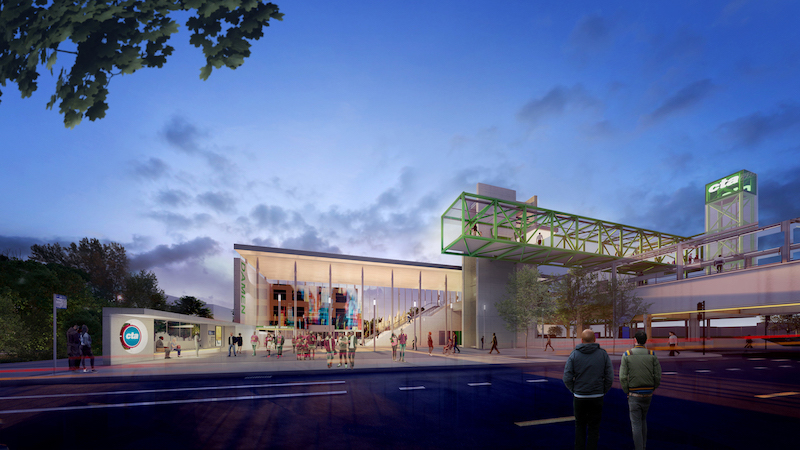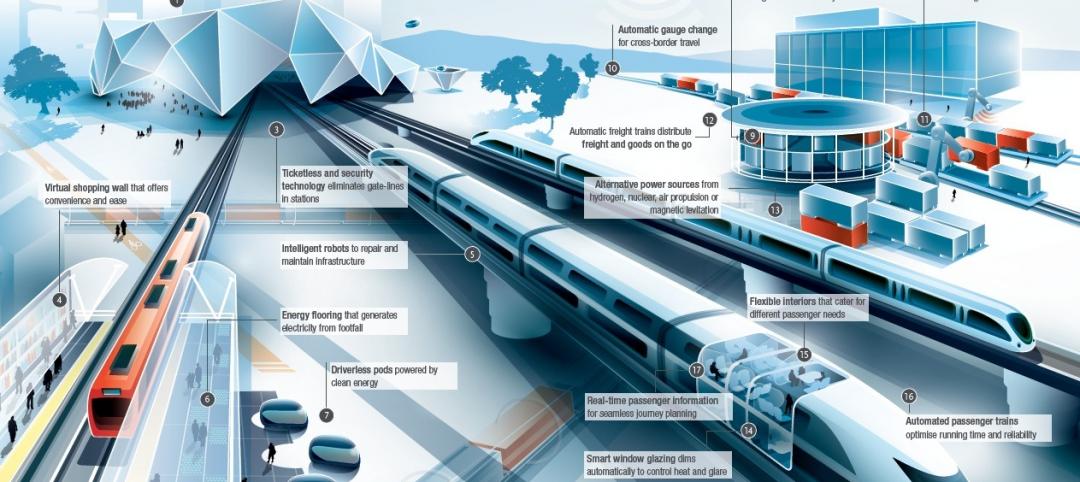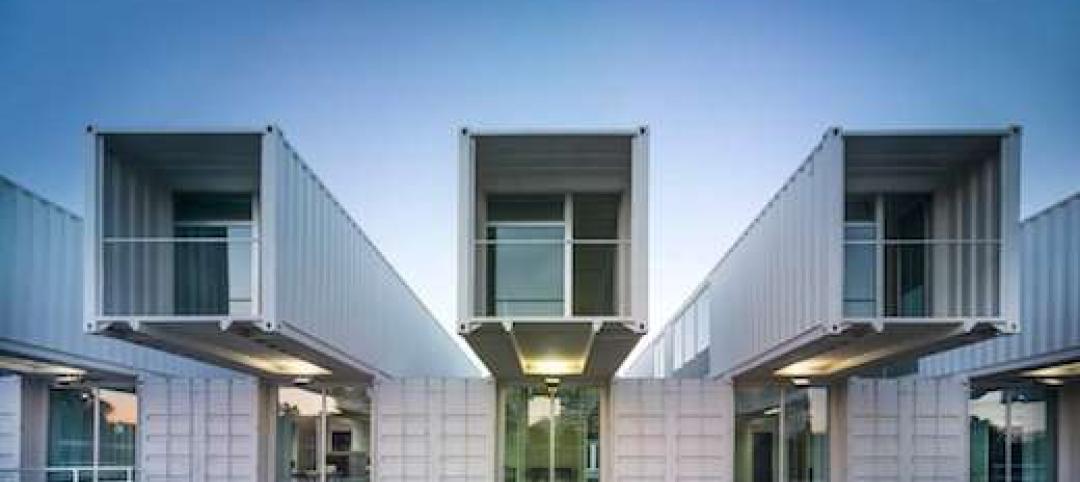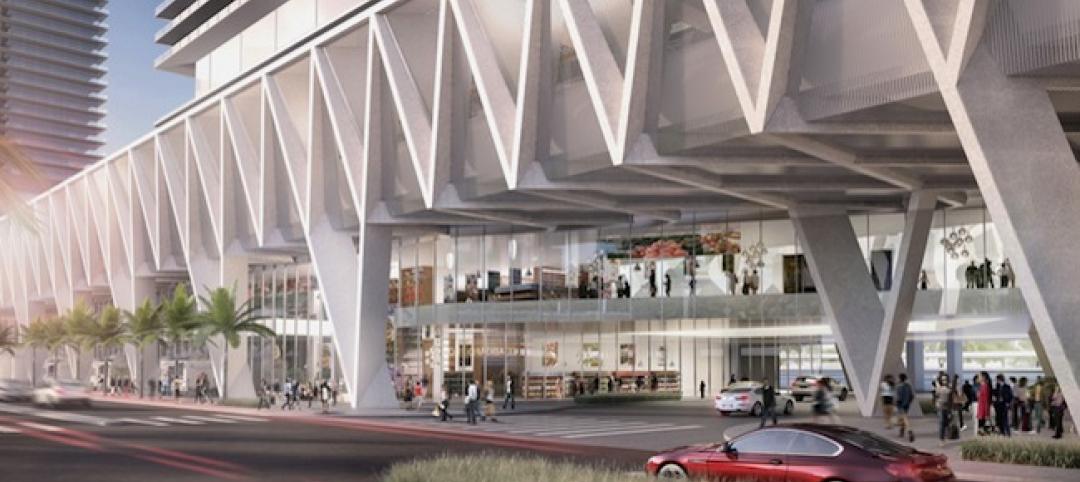For the first time since 1948, part of the Near West Side of Chicago will have train access to it, and an easy way to travel far beyond. Plans for the Damen Green Line Station, a new glass-walled transportation center to be located at Damen Avenue and Lake Street, recently were unveiled.
With glass walls, open sightlines meant to give broad views of Chicago, and a landmark green truss mimicking both the city’s bridges and the Green Line itself, the planned transit center will serve as a connection point for train-to-bus riders, at nearly every hour of the day and night. Designed by Perkins+Will, the open-concept structure will be brightly illuminated to provide a safe atmosphere.
Having a public art installation, a grand staircase and elevated glass towers, the structure is meant to be eye-catching, but also intended as a spot from which the eye can wander. Capped by a bridge comprised of a glass-enclosed passageway supported by what might one day be considered iconic green steel trusses, the bridge will connect outbound and inbound passengers, and perhaps connect both Chicagoans and visitors to the city with the visual impact of the city itself, by way of the sweeping views if it.
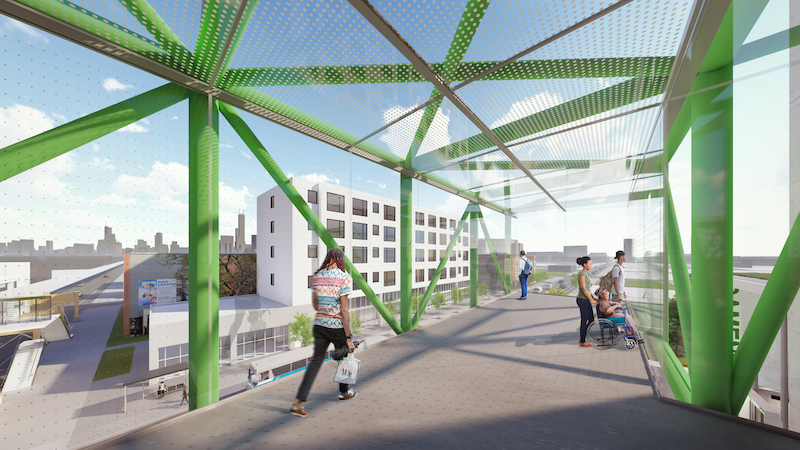
“Today’s groundbreaking marks another major milestone for the CTA, which brings new jobs and opportunities for Chicago’s residents,” Mayor Rahm Emanuel says. “This new station will be a community anchor, serve those who live and work in the neighborhood, and will become a gateway to further usher in economic growth for the Near West Side.”
Perkins+Will has designed more than 120 transit stations around the world. The Damen Green Line Station is the latest of those public transit developments.

“We are excited to partner with the City of Chicago on this important project in our own backyard,” says Douglas Smith, Managing Principal at Perkins+Will. “We are a Chicago-based firm, so are proud to use our global expertise to enhance the public transit experience of Chicago Transit Authority (CTA) riders and help return access and investment to this community.”
Related Stories
| Jun 30, 2014
Research finds continued growth of design-build throughout United States
New research findings indicate that for the first time more than half of projects above $10 million are being completed through design-build project delivery.
| Jun 30, 2014
Arup's vision of the future of rail: driverless trains, maintenance drones, and automatic freight delivery
In its Future of Rail 2050 report, Arup reveals a vision of the future of rail travel in light of trends such as urban population growth, climate change, and emerging technologies.
| Jun 18, 2014
Arup uses 3D printing to fabricate one-of-a-kind structural steel components
The firm's research shows that 3D printing has the potential to reduce costs, cut waste, and slash the carbon footprint of the construction sector.
| Jun 12, 2014
Austrian university develops 'inflatable' concrete dome method
Constructing a concrete dome is a costly process, but this may change soon. A team from the Vienna University of Technology has developed a method that allows concrete domes to form with the use of air and steel cables instead of expensive, timber supporting structures.
| Jun 6, 2014
Shipping container ship terminal completed in Spain
In Seville, Spain, architectural firms Hombre de Piedra and Buró4 have designed and completed a cruise ship terminal out of used shipping containers.
| Jun 2, 2014
Parking structures group launches LEED-type program for parking garages
The Green Parking Council, an affiliate of the International Parking Institute, has launched the Green Garage Certification program, the parking industry equivalent of LEED certification.
| Jun 2, 2014
SOM unveils plans for Miami transit hub
The elevated station will be a key portal within All Aboard Florida’s rail system, the nation's only privately owned, operated, and financed rail network.
| May 29, 2014
7 cost-effective ways to make U.S. infrastructure more resilient
Moving critical elements to higher ground and designing for longer lifespans are just some of the ways cities and governments can make infrastructure more resilient to natural disasters and climate change, writes Richard Cavallaro, President of Skanska USA Civil.
| May 20, 2014
Kinetic Architecture: New book explores innovations in active façades
The book, co-authored by Arup's Russell Fortmeyer, illustrates the various ways architects, consultants, and engineers approach energy and comfort by manipulating air, water, and light through the layers of passive and active building envelope systems.
| May 19, 2014
What can architects learn from nature’s 3.8 billion years of experience?
In a new report, HOK and Biomimicry 3.8 partnered to study how lessons from the temperate broadleaf forest biome, which houses many of the world’s largest population centers, can inform the design of the built environment.


